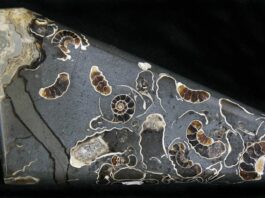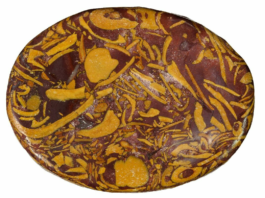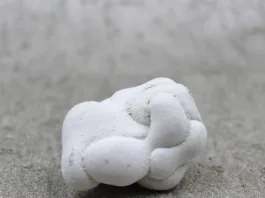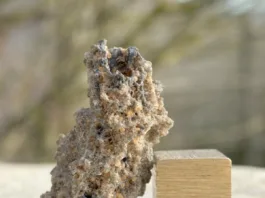Breccia is a type of sedimentary rock that plays a significant role in the field of geology. It is characterized by its distinctive appearance, which consists of angular rock fragments and clasts that are cemented together. These rock fragments can vary in size from small pebbles to large boulders, and they are typically surrounded by a fine-grained matrix that serves as the cementing material. Breccia forms through a process known as brecciation, which involves the fracturing and reassembly of rocks.


Overview: Breccia is a common rock type found in a variety of geological settings, including fault zones, impact craters, and alluvial fan deposits. Its formation can result from a range of geological processes, and it often preserves valuable information about the history and conditions of its formation. There are several different types of breccia, including fault breccia, impact breccia, and volcanic breccia, each with its unique characteristics and formation processes.
Importance in Geology: Breccia is important in the field of geology for several reasons:
- Structural Analysis: The angular fragments within breccia can provide valuable information about the forces and stresses that caused the rocks to fracture and break apart. Geologists can study the orientation and arrangement of clasts to gain insights into the history of deformation and faulting in an area.
- Impact Events: Impact breccia is often associated with meteorite or asteroid impact sites. By studying impact breccia, geologists can learn about the size, velocity, and angle of impact, as well as the environmental consequences of such events.
- Mineral Deposits: Breccia can serve as a host rock for mineral deposits. Ore minerals may be concentrated within the fractures and pore spaces of brecciated rocks, making it an important target for mineral exploration.
- Paleontology: In some cases, fossils or ancient organisms can become incorporated into breccia during its formation. The study of fossil-bearing breccia can provide insights into past ecosystems and environmental conditions.
- Hydrogeology: Breccia can influence groundwater flow and aquifer characteristics. The porosity and permeability of brecciated rocks can vary, affecting the movement of water and the potential for groundwater contamination or resource extraction.
- Geological History: Breccia can serve as a geological record, preserving evidence of past geological events and processes. By analyzing brecciated rocks, geologists can reconstruct the history of an area, including faulting, erosion, and sedimentation.
In summary, breccia is a diverse and informative rock type that holds important clues about geological processes, structural geology, impact events, mineral resources, and environmental conditions. Its study and analysis contribute significantly to our understanding of Earth’s history and the processes that have shaped our planet.
Texture: clastic (coarse-grained).
Grain size: > 2mm; clasts easily visible to the naked eye, should be identifiable.
Hardness: Soft to hard, dependent on clast composition and strength of cement.
Colour: Dependent on clast and matrix composition.
Clasts: variable, but generally harder rock types and / or minerals dominate.
Other features: Rough to touch due to angular clasts.
Contents
Classification of Breccia

Breccia can be further divided according to:
Class – may be divided into two huge lessons:
- Clast supported – in which the clasts contact each different and the matrix fills the voids; and
- Matrix supported – where the clasts are not in contact and the matrix surrounds each clast;
Clast size – quality (2 – 6mm), medium (6 – 20mm), coarse (20 – 60mm), very coarse (> 60mm);
Sorting – a comprising a mixture of clast sizes is poorly taken care of, at the same time as one comprising mainly clasts of the equal size is well sorted;
Lithology – wherein the clasts constitute a couple of rock kind is named polymictic (or petromictic), while one where the clasts are of a single rock type are monomictic (or oligomictic).
There are many different names of breccias. It given names to common used when referring to a rock or rock debris made up of angular fragments. Although it is mainly used for rocks of sedimentary origin, it can be used for other types of rocks.
Collapse Breccia: Crushed rock that reason from a cavern or magma chamber collapse.
Fault Breccia or Tectonic Breccia: Crushed rock found in the contact area between two fault blocks and produced by movement of the fault.
Flow Breccia: A lava texture produced when the crust of a lava flow is broken and jumbled during movement.
Fold Breccia: formed by the folding and breakage of thin, brittle rock layers which are interlayered with incompetent, ductile layers.
Igneous Breccia or Volcanic Breccia: A term used for a rock composed of angular fragments of igneous rocks. “Flow breccia” and “pyroclastic breccia” could be called “igneous breccia.”
Impact Breccia: A deposit of angular rock debris produced by the impact of an asteroid or other cosmic body. See an article about “impactites.”
Monomict Breccia: whose clasts are composed of a single rock type, possibly all from a single rock unit.
Polymict Breccia: A breccia whose clasts are composed of many different rock types.
Pyroclastic Breccia: A term used for a deposit of igneous rock debris that was ejected by a volcanic blast or pyroclastic flow.
When you hear the word “breccia” used in reference to a rock or rock material, it is fairly safe to assume that it means angular-shaped pieces.
Chemical Composition of Breccia

It is the accumulation of rock fragments, so consequently the lithic fragments will describe the sort of breccia. As the composition of breccia is of different sorts this influence on sort of rock fragments inclusive of, sandstone breccia, limestone breccia, granite breccia and so forth. Other breccia which contains one-of-a-kind rock fragments are referred to as polymictic breccia.
Colour of Breccia: Breccia can be of different colour depending at the sort of angular fragments coloration. The coloration of the matrix and rock fragments determine the color of the breccia.
Difference Between Breccia and Conglomerate
Both the breccia and conglomerate are clastic sedimentary rock which have fragments over 2 millimetre length. The distinction among them lies in the shape of the fragments. The particles of breccia would be angular and people of the conglomerate could be round. If any of those rock is but some distance from the source rock it could usually be differentiated by the particle form.
Formation of the Rock

Sedimentary Breccia
Sedimentary breccia is a type of clastic sedimentary rock which is fabricated from angular to subangular, randomly orientated clasts of different sedimentary rocks. A conglomerate, by using evaluation, is a sedimentary rock composed of rounded fragments or clasts of pre-existing rocks. Both breccia and conglomerate are composed of fragments averaging greater than 2 millimetres (0.079 in) in length.
It consists of angular, poorly sorted, immature fragments of rocks in a finer grained groundmass which can be produced by way of mass wasting. Thick sequences of sedimentary (colluvial) breccia are typically shaped subsequent to fault scarps in grabens. It can also arise along a buried flow channel wherein it shows accumulation alongside a juvenile or hastily flowing move.
It can be shaped via submarine debris flows. Turbidites occur as fine-grained peripheral deposits to sedimentary breccia flows.
In a karst terrain, a collapse breccia can also form due to disintegrate of rock right into a sinkhole or in cave development.
Fault Breccia
Fault breccia consequences from the grinding movement of fault blocks as they slide past every other. Subsequent cementation of those damaged fragments may arise by means of the creation of mineral remember in groundwater.
Igneous
Igneous clastic (detrital) rocks can be divided into two instructions:
- Broken, fragmental rocks related to volcanic eruptions, both of the lava and pyroclastic kind;
- Broken, fragmental rocks produced by intrusive approaches, typically associated with plutons or porphyry shares.
Volcanic pyroclastic rocks are fashioned by means of explosive eruption of lava and any rocks which might be entrained within the eruptive column. This may additionally consist of rocks plucked off the wall of the magma conduit, or bodily picked up by the following pyroclastic surge. Lavas, especially rhyolite and dacite flows, have a tendency to form clastic volcanic rocks by a method called autobrecciation. This occurs while the thick, nearly strong lava breaks up into blocks and those blocks are then reincorporated into the lava flow again and jumbled together with the ultimate liquid magma. The ensuing breccia is uniform in rock kind and chemical composition.
Within the volcanic conduits of explosive volcanoes the volcanic breccia surroundings merges into the intrusive breccia environment. There the upwelling lava tends to solidify at some point of quiescent durations handiest to be shattered via ensuing eruptions.
Impact
Impact breccias are notion to be diagnostic of an impact occasion consisting of an asteroid or comet placing the Earth and are typically located at impact craters. Impact breccia, a type of impactite, forms throughout the technique of effect cratering whilst big meteorites or comets impact with the Earth or other rocky planets or asteroids. Breccia of this kind can be gift on or below the ground of the crater, in the rim, or inside the ejecta expelled beyond the crater. Impact breccia can be diagnosed by its prevalence in or around a regarded impact crater, and/or an affiliation with different products of impact cratering including shatter cones, impact glass, bowled over minerals, and chemical and isotopic evidence of contamination with extraterrestrial cloth (e.G. Iridium and osmium anomalies).
Hydrothermal
Hydrothermal breccias generally form at shallow crustal levels (<1 km) among one hundred fifty and 350 °C, whilst seismic or volcanic interest causes a void to open along a fault deep underground. The void draws in hot water, and as pressure within the cavity drops, the water violently boils. In addition, the sudden beginning of a cavity causes rock at the perimeters of the fault to destabilise and implode inwards, and the broken rock receives caught up in a churning combination of rock, steam and boiling water. Rock fragments collide with every other and the perimeters of the void, and the angular fragments become greater rounded. Volatile gases are lost to the steam section as boiling continues, specifically carbon dioxide. As a end result, the chemistry of the fluids adjustments and ore minerals unexpectedly precipitate. Breccia-hosted ore deposits are quite commonplace.
The morphology of breccias associated with ore deposits varies from tabular sheeted veins and clastic dikes associated with overpressured sedimentary strata, to massive-scale intrusive diatreme breccias (breccia pipes), or maybe a few synsedimentary diatremes fashioned solely by way of the overpressure of pore fluid within sedimentary basins. Hydrothermal breccias are usually formed through hydrofracturing of rocks by way of highly compelled hydrothermal fluids. They are ordinary of the epithermal ore environment and are intimately associated with intrusive-related ore deposits which include skarns, greisens and porphyry-related mineralisation. Epithermal deposits are mined for copper, silver and gold.
Breccia Locatilies
Breccia can be found in various geological settings around the world. Its presence in a specific location depends on the geological processes that have occurred there. Here are some common locations where breccia can be found:
- Fault Zones: Fault breccia forms along fault lines where rocks fracture and displace due to tectonic forces. These angular rock fragments are often cemented together by minerals like quartz, calcite, or clay. Fault breccia can be observed along active and inactive fault lines.
- Impact Craters: Impact breccia is commonly associated with meteorite or asteroid impact craters. These craters are created when celestial objects collide with the Earth’s surface, causing intense shockwaves and fracturing of rocks. The resulting impact breccia preserves evidence of the impact event and is often found in and around the crater rim.
- Volcanic Environments: Volcanic breccia can form in volcanic settings when explosive eruptions fragment and mix various types of volcanic rocks. These brecciated deposits can be found near volcanoes, in volcanic calderas, and within volcanic ash layers.
- Alluvial Fans: Alluvial fan breccia forms in arid regions where fast-flowing water carries rock fragments and sediments downhill. These deposits accumulate at the base of mountains or hills and can be cemented over time, forming alluvial fan breccia.
- Submarine Environments: In underwater settings, sedimentary rocks called turbidites can contain brecciated layers. Turbidites are formed by underwater landslides or sediment gravity flows, which can lead to the creation of breccia layers within the sedimentary sequence.
- Cave Environments: Cave breccia can develop within caves through a combination of processes, including cave collapses, erosion, and sedimentation. It often consists of broken cave formations, rock fragments, and sediment.
- Mineral Deposits: Breccia can be associated with ore deposits, especially in hydrothermal and vein systems. Ores, along with their associated minerals, can fill fractures and openings within brecciated rocks.
- Subduction Zones: In subduction zones, where one tectonic plate is forced beneath another, intense pressure and deformation can create breccia within the subducting plate or along the plate boundary.
- Sedimentary Basins: In sedimentary basins, tectonic activity, such as uplift and folding, can result in the formation of brecciated layers within sedimentary sequences.
- Historical and Cultural Sites: In some cases, breccia formations may be used in architectural and construction applications. Breccia stones have been used historically in the construction of buildings and monuments.
These are just a few examples of the many geological settings where breccia can be found. The specific type of breccia and its characteristics can vary widely depending on the geological history and processes at each location. Geologists study these breccia formations to gain insights into the Earth’s geological history and the processes that have shaped various regions.
Characteristics and Properties of Breccia

The identifying feature of breccia is that it consists of visible angular clasts cemented together with another mineral. The clasts should be easily visible to the naked eye. Otherwise, the properties of the rock are highly variable. It can occur in any color, and may be either hard or soft. The rock may be rough to the touch because of the angular clasts. Whether it polishes to a smooth surface depends on the similarity of clast and matrix composition.
- It is a clastic sedimentary rock. The clasts are irregularly shaped particles greater than two millimeters in diameter. The cement binding the clasts is a matrix made of smaller particles.
- Breccia and conglomerate rock are similar. The clasts in breccia are angular, while the clasts in conglomerate rock are rounded.
- It comes in many colors and compositions.
- It is mainly used to make decorative architectural elements. It may be polished to make decorative features or gemstones. It can be used as a road base or fill.
Uses and Application
Because of its variable composition, breccia has an interesting appearance. The rock is mainly used to make sculptures, gems, and architectural elements. The Minoan palace of Knossos on Crete, constructed around 1800 BC, includes columns made of breccia. The ancient Egyptians used breccia to make statues. The Romans regarded breccia as a precious stone and used it to construct public buildings, columns, and walls. The Pantheon in Rome features columns made of pavonazzetto, a type of breccia with a pattern resembling peacock feathers. In modern culture, breccia is used for decorative elements, jewelry, and sometimes as a fill material for roads.
Facts About The Rock
- It is very similar to conglomerate. The main difference is the fragments in breccia have not been rounded by the action of moving water as in a conglomerate.
- Silica, calcite and iron oxides are the most common cementing minerals.
- There are many compositions of Breccia. The composition is determined by the mineral material and rock that the angular fragments were produced from.
- The composition of breccia can be influenced by the climate.
- The type of rock that the fragments were produced from is often used as an adjective in the name of the rock. For example: granite breccia, sandstone breccia, granite breccia, basalt breccia and chert breccia.
- When a breccia contains many types of rock fragments, they are known as polymict breccias or polymictic breccias. For example, a breccia that contains clasts of multiple types of limestone is referred to as a limestone breccia.
- Breccia can be a colorful rock. The colors of the matrix or cement, along with the color of the rock fragments, determine its color.
- This rock is used as architectural stones for paving stone, building stone, tiles, window sills, and interior building veneers.
- The word breccia originated from the Italian language which means “loose gravel”.
- Sedimentary breccia may be formed by the debris flow of a submarine.
- Fault breccia is produced by fracture and grinding during faulting and found within the fault plane.
- When lavas pick up rock fragments, they can form volcanic breccia, also referred to as pillow breccias. When the crust of a lava flow is broken up during movement, it is called flow breccia.
- An impact breccia is rocks composed of angular rock fragments from the impact of an android.
References
- Bonewitz, R. (2012). Rocks and minerals. 2nd ed. London: DK Publishing.
- https://www.answers.com/Q/Where_can_you_find_breccias
- Wikipedia contributors. (2019, April 4). Breccia. In Wikipedia, The Free Encyclopedia. Retrieved 22:24, April 10, 2019, from https://en.wikipedia.org/w/index.php?title=Breccia&oldid=890928086
- Helmenstine, Anne Marie, Ph.D. (2018, October 19). Breccia Rock Geology and Uses. Retrieved from https://www.thoughtco.com/breccia-rock-4165794
- http://www.softschools.com/facts/rocks/breccia_facts/3019/






